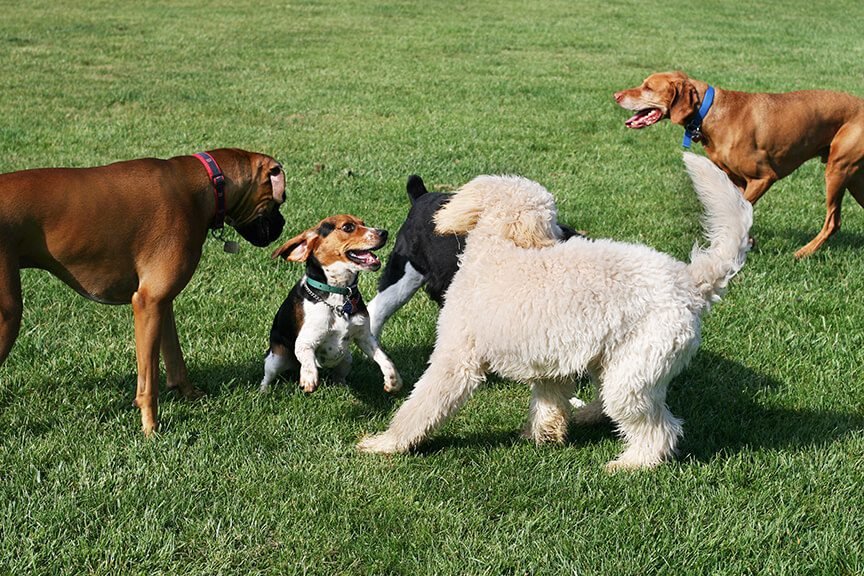Moving to a new country is an exciting adventure, but it can also be a big adjustment for our four-legged friends. Dogs who grew up in other countries will have to get used to different social norms when they are brought into the United States. As dog owners, it’s our responsibility to learn proper socialization norms for our dogs and to help them adapt to the new environment and properly integrate into American life.
The socialization process lays the foundation for our dogs to feel comfortable navigating all the novel experiences that come with immigrating to the U.S. In this comprehensive guide on socializing dogs, we will explore ways to help your dogs settle in their new country, whether your dog is a puppy or an adult dog.
The Importance of Ongoing Socialization - for Both Puppies and Adult Dogs
Before diving into U.S.-specific advice, let’s first review some core principles of dog socialization that can be applied universally. Socialization should be an ongoing process, not a one-time event. Being gradually and positively exposed to a wide variety of sights, sounds, smells, people, animals, and locations should occur throughout a dog’s life.
Focus on creating positive experiences. Always make sure your dog feels safe and has fun during socialization outings. Forcefully flooding them with stressful interactions often backfires. Instead, take it slowly and supervise carefully. Socialization requires ample patience. Pay close attention to your dog’s body language and don’t push them past their comfort zone.
It is always easier to start dog training early with puppies rather than older dogs. The most impressionable window for puppy socialization is generally 3-16 weeks old, though older dogs of any age benefit greatly from continued, controlled exposure to novelty.
With this thoughtful approach to how to socialize a dog, you can reap huge rewards and help your canine companion confidently tackle the adventures that come with relocating to their new American home.
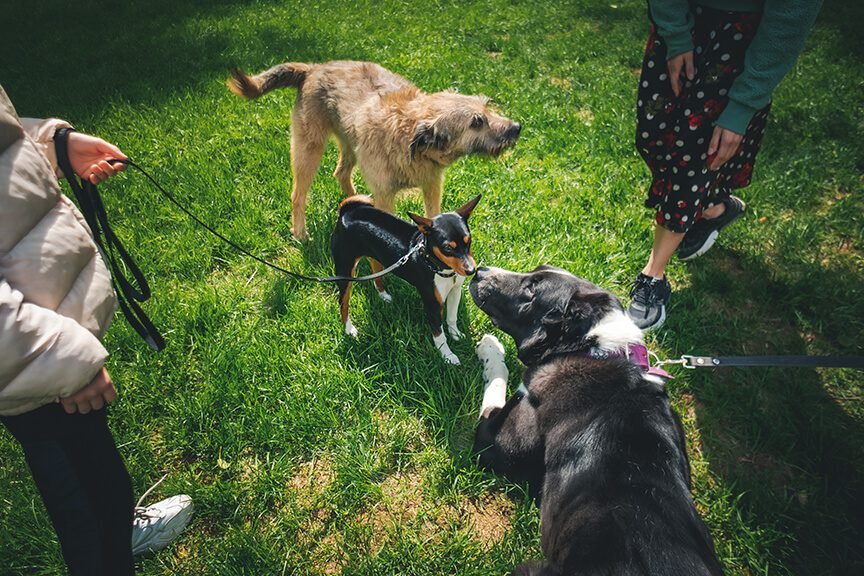
Acclimating Your Dog to Common U.S. Settings
While social norms for dogs vary worldwide, these places tend to be ubiquitous social settings in the U.S. that your dog may frequently encounter:
Dog Parks
Dog parks, both public and private, have exploded in popularity across the U.S. in recent decades. These fenced-in areas allow dogs to play together off-leash and burn energy, providing good opportunities for them to socialize adult dogs and puppies. Before your first visit, ensure your dog is up-to-date on all core vaccinations. Rabies, distemper, parvo, and kennel cough vaccines provide critical protection against contagious diseases that easily spread at parks.
For initial trips, aim for quieter times of the day so your dog isn’t overwhelmed by an avalanche of new dogs. Reward them for positive interactions with other calm, friendly dogs. However, be prepared to intervene if your dog exhibits bullying behavior or becomes aggressive. As visits continue, pay close attention to their body language and step outside the park if they become overstimulated. With patience, dog parks can become a beloved staple in your pup’s exercise and socialization routine.
Pet Stores
Many pet supply stores throughout the U.S. permit leashed dogs to accompany owners inside. Take advantage of this pet-friendly policy to socialize your dog with a host of new experiences – strange smells, crowds of people, squeaky toy noises, automatic doors, riding in carts, slick floors, and more. Walk up and down the aisles as a training opportunity, commanding their attention and rewarding good behavior. However, be alert to territorial triggers and keep moving to discourage unwanted dog barks or marking inside stores.
Cafes and Restaurants
Certain cafes and restaurants, especially in urban areas, are becoming more dog-friendly. They allow pets to join owners at outdoor patios, decks, rooftops, and sidewalk seating areas. What better way to socialize your dog than bringing them along for brunch or happy hour? Settle them on a blanket or portable bed as you dine. Reward calmness amid the hubbub of chatter, kitchen sounds, and tempting food aromas. This exposure can be a positive experience that teaches them excellent real-world manners.
Friends’ Homes
As you make new human friends in the U.S., arrange for their dogs to visit your home first. This allows your dog to socialize on their own turf, rather than being thrust unprepared into a stranger’s home. Once they are interacting smoothly, return the favor with carefully supervised playdates on neutral ground or at your friends’ homes. Having canine pals facilitates socialization and helps your dog remain calm and feel at home in America.
Vet Visits
Frequent veterinary exams will likely be the norm during your dog’s U.S. life. Transform dreaded vet visits into positive experiences by pairing the location with high-value treats and never punishing your dog there. Request complimentary “social visits” to simply weigh your dog, give treats, and leave – no exam involved. This prevents associating the vet only with negative procedures. Instead, your dog looks forward to the trip.
Public Events
The U.S. offers abundant dog-centric events open to the public, like “yappy hours,” charity walks, adoption fairs, microbrewery dog days, and more. Check online event calendars in your area. Then bring your leashed dog to stroll around these lively happenings and engage with the environment on their own terms. Moderation is key – don’t overwhelm them, but relish the socialization opportunities.
Tip: If your dog seems anxious in a public setting or around unfamiliar people, proactively step outside or take a break before trying again. Stay positive!
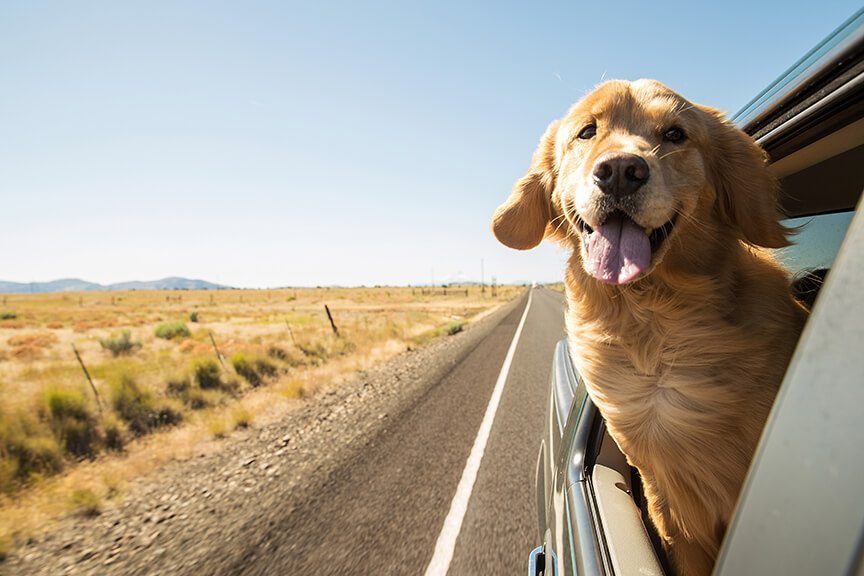
Acclimating Your Dog to U.S. Transportation
People frequently bring dogs along on transportation in the U.S. Help your dog adjust to:
Car Rides
For smooth automotive travel, use crates or restraints to keep your dog safely secured. Bring treats and make rides fun. Short, positive trips build confidence before you attempt longer journeys. Maintain a comfortable temperature and avoid direct air blowing on your dog. If they exhibit signs of car sickness, consult your vet for advice. Driving can become a staple of American adventures with your dog.
Public Transportation
Many public transit systems permit leashed dogs, though policies vary regionally. Test it out cautiously if your dog is unaccustomed to buses, subways, or trains. Hop aboard when fewer crowds are onboard and station yourselves in less trafficked cars or corners. Discourage barking but stay upbeat – public transportation may take some getting used to.
Rideshares
Popular rideshare services like Uber and Lyft often welcome pets too. Socialize your dog by booking pet-friendly drivers in advance. Follow all vehicle policies – some require crates or restrict shedding dogs. The close proximity to new people makes rideshares a fantastic controlled socialization opportunity.
Air Travel
When relocating to the U.S. your dog would likely to have just endured a long flight. Before their next air trip, allow a few weeks for recuperation. When the time comes, book direct flights to minimize hassle. Use an approved carrier and talk soothingly during the process. Request to board early to give your dog more time to settle in. Adhere to all airline and TSA pet regulations for smooth sailing.
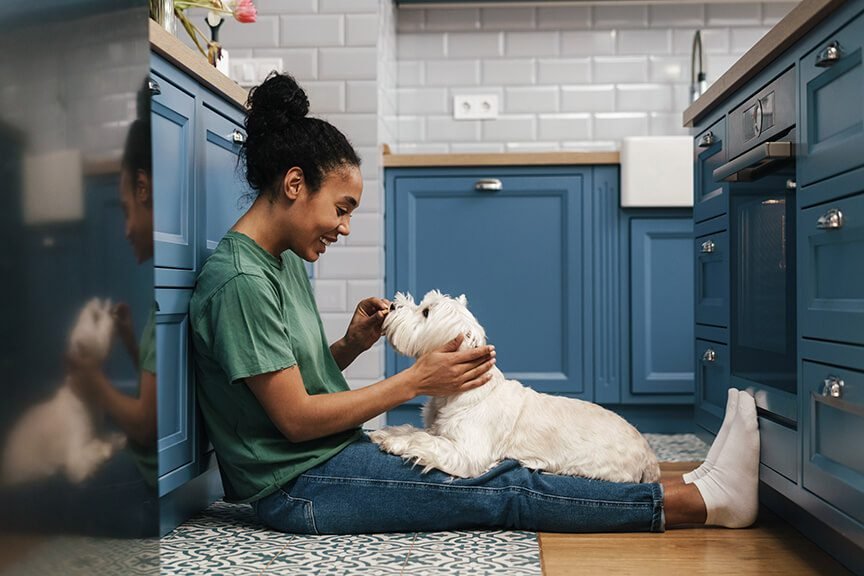
Introducing Your Dog to Elements of U.S. Home Life
Certain aspects of day-to-day home life in the U.S. may require adjustments:
Multi-Pet Households
If you adopt another rescue dog in the U.S., introduce current and new pups carefully. Initially feed, walk, train, and play with the dogs separately. No need to rush bonding! Once they seem amenable in each other’s presence, try low-key parallel activities like chewing side-by-side. Swapping scents via blankets builds positive association. With time, be ready to intervene in any disagreements as they figure out relationship dynamics.
Dog Walkers/Daycare
Does your job keep you away from home for many hours? Dog walking or doggie daycare services help your dog exercise and socialize during your absence. However, if your dog is unaccustomed to time away and handling by strangers, or is prone to separation anxiety, take things slowly. Thoroughly screen potential walkers or facilities first. Request meet-and-greets on neutral ground to gauge your dog’s reaction, and share any tips on their personality upfront. Starting conservatively prevents overwhelm.
Backyard Time
Part of your new home may include direct backyard access. Fantastic! But allow your dog time to learn the parameters of your new yard or balcony before leaving them unsupervised. Work on solidifying their recall skills and obedience to commands. Ensure fencing is secure, flags mark underground wires, and gates latch properly. Beware of potential wildlife dangers too like neighboring coyotes, foxes, or skunks. You want your backyard to be a sanctuary.
Noisy Neighbors
Your new home may subject your dog to sounds they’ve never experienced before, like nearby construction, music, garbage trucks, or a neighboring school. Utilize recordings to desensitize them to these ambient noises, starting at a very low volume and associating the sounds with treats for calm responses. Take it step-by-step – soon those booming fireworks won’t phase them!
House Guests
A flurry of new human guests may filter through your doors as you settle into American life. In order to acclimate your dog to visitors, try to:
- Keep them leashed, crated, or separated during initial introductions.
- Avoid direct eye contact, hovering over your dog, or immediately touching them.
- Have guests offer high-value treats once your dog remains composed in their presence.
- As your dog seems comfortable, teach guests how to appropriately interact with pets before engaging directly.
Tip: If your dog struggles with prolonged fear or aggression issues around strangers, quickly consult a trainer or behaviorist.
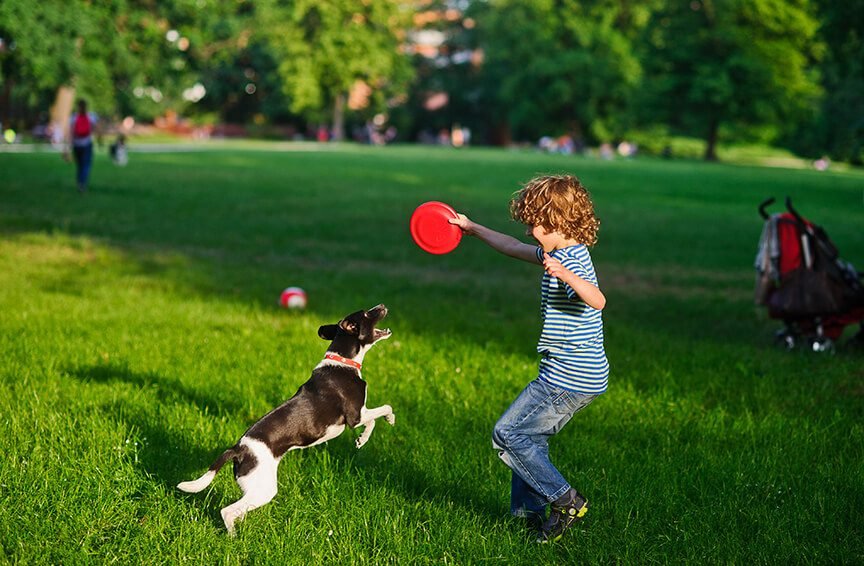
Mastering U.S. Dog Park Etiquette
Dog parks are a beloved fixture across the U.S., but expectations may differ from other countries you’ve lived in. Here’s a refresher on proper dog park etiquette.
Pick Up After Your Dog
Carry waste bags and promptly clean up any messes your dog makes, without exception. This prevents contamination and parasite transmission.
Mind Your Dog's Manners
Friendly chasing and play is usually fine, but immediately intervene if your dog shows bullying behavior or becomes too rough.
Visit During Off-Peak Times If Your Dog is Leash Aggressive
If your dog acts overly defensive or aggressive toward other dogs while leashed, opt for visiting parks during quieter hours when fewer dogs are around. Always leash your dog when entering and exiting.
Leave Young Kids at Home
Most parks prohibit children under age 12 from entering for safety reasons. When supervising, keep kids away from unattended dogs and avoid small dog areas.
No Toys or Treats
High-value items often instigate conflicts, with dogs competing over possessions. For smooth interactions, toys and treats are better reserved for home play.
Respect Separate Areas
Some parks offer designated sections for small vs. large dogs. Abide by size limits and keep big dogs out of the small dog zone.
Tip: When in doubt, give unfamiliar dogs ample space. And if any issues arise, politely discuss concerns with the other owner.
Warming Shy Dogs Up to New Friends
Does your dog seem anxious when greeting other dogs or people? If yes, be mindful of taking things slowly and don’t force interactions. Let shy dogs set the speed of introductions and adjust the socialization period accordingly Note body language cues of discomfort like lip licking, yawning, shaking, or ears back. Help them disengage if needed.
Try low-pressure parallel play, like walking side-by-side at a comfortable distance. Use high-value treats to motivate calm interactions and build positive feelings.
Avoid direct approaching, which dogs find confrontational. Instead, angle your body sideways and gentle petting can help reassure timid dogs when interacting nicely, but don’t overcrowd them.
Public settings like crowded parks may be too overwhelming at first. Seek calmer socialization outlets to build skills.
Tip: If anxiety persists and significantly impacts the quality of life, a veterinary behaviorist can custom-design a training plan.

Picking Up on Common U.S. Dog Cues
While dog body language fundamentals hold true universally, social cues also have nuanced cultural contexts. Here are some signals Americans often observe in local dogs:
- Play Bows – Crouching frontwards with a rump in the air often accompanies friendly play invitations. Watch for this lighthearted cue.
- Lip Licking – Not inherently stressful here – some U.S. dogs lick their lips when focused during training or aroused for play.
- Happy Tail Wagging – Relaxed, upright tail wagging typically signals a happy, social dog looking to engage.
- Short Greeting Barks – At parks, dogs commonly vocalize a few quick barks to say hello upon meeting new canine pals.
- Subtle Signs to Give Space – American dogs sometimes rely on subtle body shifts like turning away, slow sitting, sniffing the ground, etc. to signal they want distance.
Tip: When playing, most yelping and mouthing is friendly, but intervene if things escalate. Know your dog’s boundaries.
Everyday Social Skills for the Well-Mannered Dog
Mastering manners and impulse control helps set our dogs up for success. Practice these essential skills daily:
- Loose Leash Walking – Work on ignoring distractions and not pulling while leashed, even in exciting environments. This mental exercise teaches vital self-control.
- “Leave It” with Food – With rewarding treats nearby, command “leave it” and praise your dog for obeying. Alternatively, swap human food for an approved chew toy to teach them not to beg while you eat.
- “Say Please” First – Before mealtime, exits, pets, toys, or anything your dog wants, ask for a simple cue like “sit” or “down” first. This builds patience and politeness.
- Polite Greetings – Coach strangers to ignore jumping up and reward all four paws staying on the floor. Teach your dog to say hello only when given permission.
- Handling Desensitization – Regularly touch paws, ears, mouth, and tail. Reward cooperation with nail trims, brushing, and vet exams to prevent struggles.
Tip: Keep training positive with short, energetic sessions. End on accomplishments to empower your dog
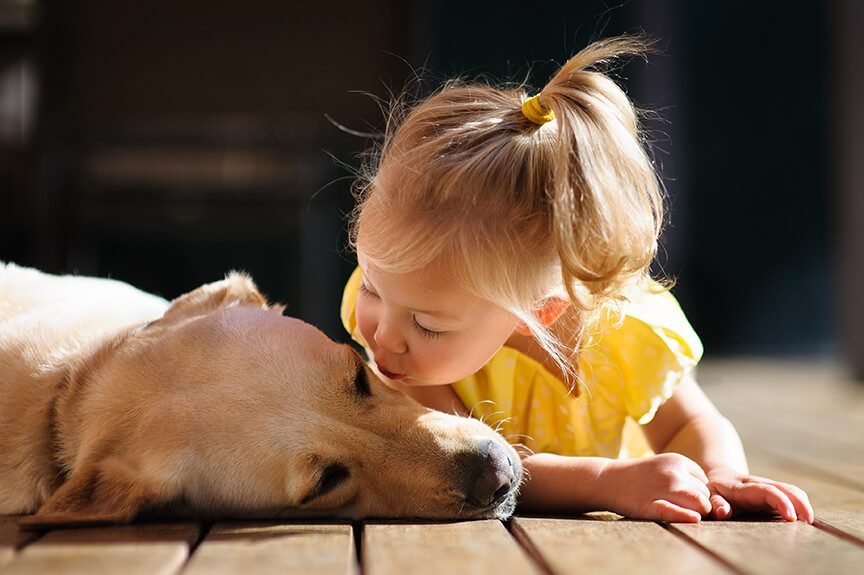
Carefully Socializing Dogs with U.S. Kids
Kids and dogs can make wonderful companions, but careful introduction is essential.
Initially, leash your dog and have the children sit calmly. Reward your pup for approaching kids on their own terms. Coach kids how to properly interact with pets – gentle stroke on the shoulders or chest, no pulling ears or tail. Show children how to recognize when dogs need space, such as turning away, licking lips, or yawning. Explain these aren’t smiles. Help kids understand hugs and staring can seem confrontational or intimidating to shy dogs unaccustomed to kids.
It is important to avoid dangerous misinterpretations. Barking or growling isn’t necessarily playful – sometimes dogs say “back off!”. Children running and yelling excites dogs, sometimes leading to chasing or nipping. Make sure play is appropriate. With supervision only, avoid overstimulating your dog and provide crates or rooms for breaks. Rotate human one-on-one time too!
Tip: Never leave young kids and dogs unattended – monitor closely. And teach kids that dog toys and food are off-limits
Get Comfortable on Outdoor Adventures
In the U.S., many owners incorporate their pets into active outdoor pastimes. Get your dog acclimated to joining common adventures like:
Hiking – Build up the distance gradually. Ensure proper leash walking etiquette when passing others on trails.
Camping – Prep your dog for the tent, new noises, and sleeping outdoors. Bring a tie-out, crate, or keep them close at night. Practice recall.
Canoeing – Introduce your dog to watercraft slowly. Secure them with a specially fitted life jacket and don’t leave unsupervised.
Fishing Outings – Dogs will investigate tackle boxes, bait, gear, and catches. Train a solid “leave it” command and redirect their energy.
Hunting Trips – For bird-hunting breeds, invest time introducing them to firearms sounds and training for steady walking at heal.
Athletic Events – If your pup excels at agility, flyball, dock diving, dog runs, or other dog sports, conditioning and spectator exposure is key.
Tip: Ensure your dog has identification, vaccines, medications, hydration/nutrition, and flea/tick prevention for outdoor fun.

Comparing Socialization Approaches Across Cultures
Interestingly, socialization practices for dogs can vary significantly across different countries and cultures.
In the U.S., off-leash dog parks are hugely popular for exercise and socialization, but these are less common in many European and Asian countries where leash laws are stricter.
Allowing dogs in restaurants and stores is becoming more widespread in the U.S., while other cultures restrict dog access to maintain traditional etiquette.
U.S. dogs are often viewed as family members with close bonds, whereas some cultures still view dogs primarily as work animals and protectors.
American dogs often sleep indoors with their owners, while dogs sleeping outside are more customary in various cultures.
In the U.S., off-leash dog parks are hugely popular for exercise and socialization, but these are less common in many European and Asian countries where leash laws are stricter.
Urban U.S. dogs frequently utilize dog walkers and daycare, but this is less prevalent in developing regions lacking comparable services.
Enrolling dogs in dog training classes starting as puppies is routine in the U.S., while more minimal formal training is the norm elsewhere.
Interacting and playing energetically with pet dogs is embraced in American culture, while other cultures discourage overly familiar, stimulated play.
Settling Into a New Home Together
Adapting to a foreign culture presents unique challenges – for people and pets alike! But armed with these tips, you can help your immigrant dog conquer socialization and thrive in the United States. Show them ample love and patience through the transition period. Before you know it, you’ll have a happy, healthy, well-adjusted, and well balanced dog to explore and enjoy your new home with for years to come.
Welcome to the U.S.A!

